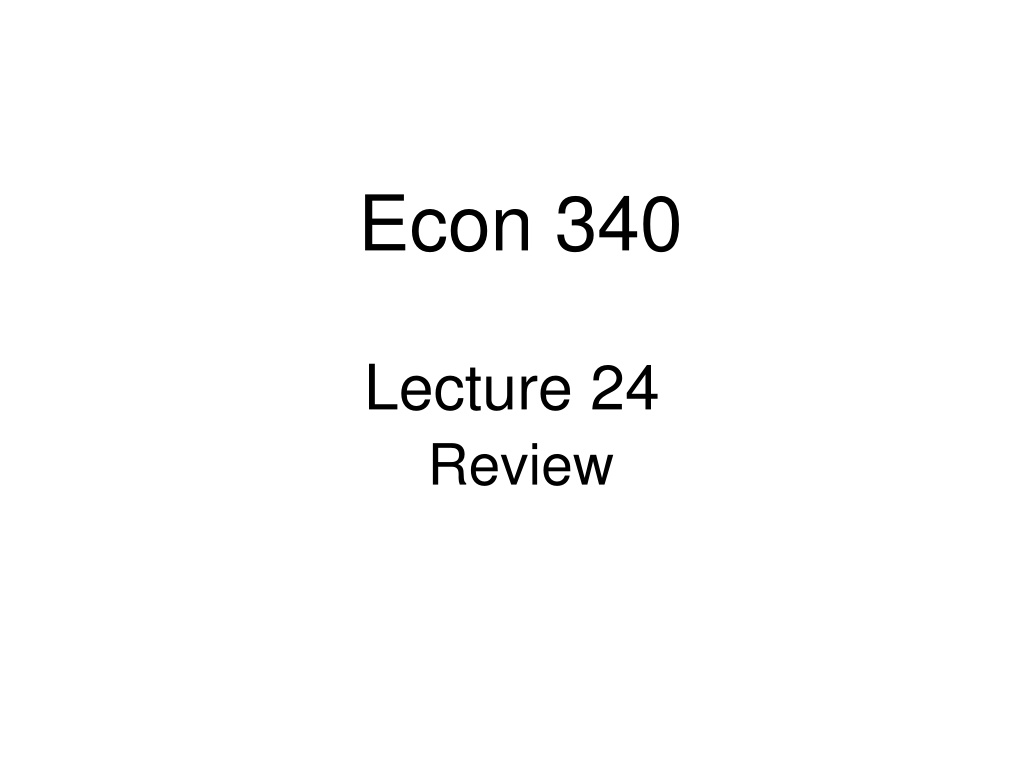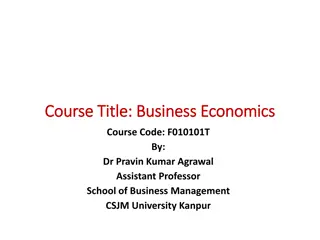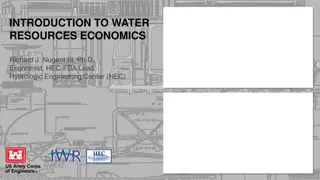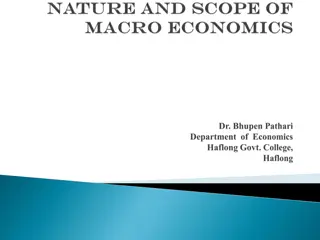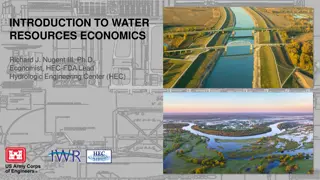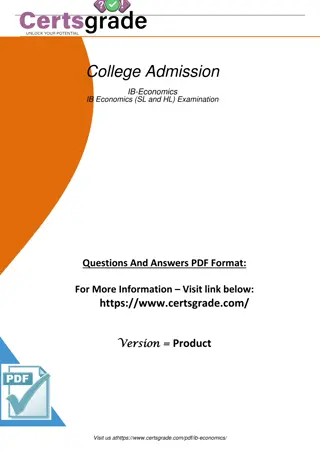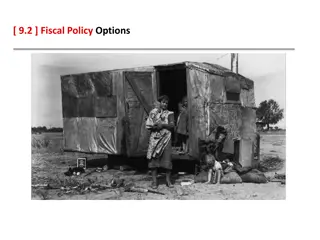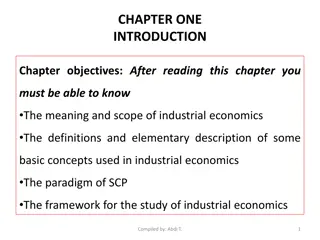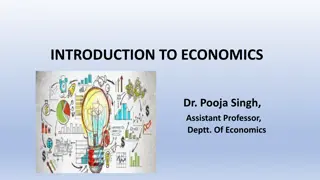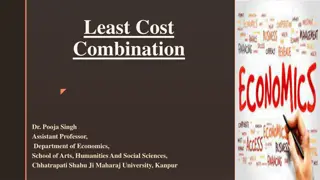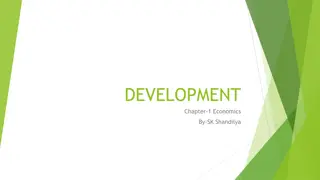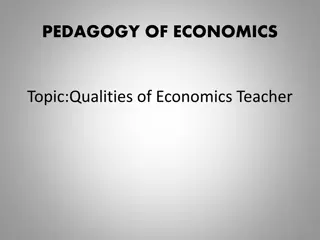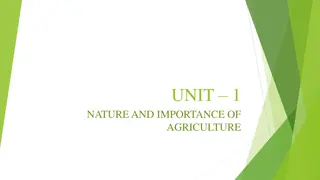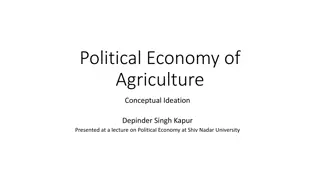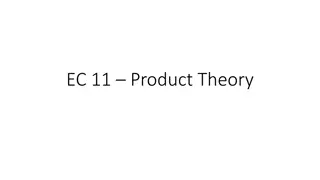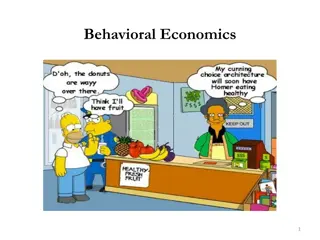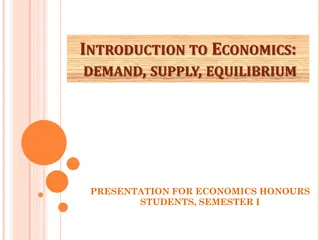International Economics: Review and Analysis
Explore key topics in international economics such as the world economy, current tensions, and gains from trade. Topics include global trade patterns, trade relationships, economic models, trade tensions, and comparative advantage. Dive into terms, acronyms, and questions related to these concepts for a comprehensive understanding of the subject.
Uploaded on Sep 26, 2024 | 0 Views
Download Presentation

Please find below an Image/Link to download the presentation.
The content on the website is provided AS IS for your information and personal use only. It may not be sold, licensed, or shared on other websites without obtaining consent from the author.If you encounter any issues during the download, it is possible that the publisher has removed the file from their server.
You are allowed to download the files provided on this website for personal or commercial use, subject to the condition that they are used lawfully. All files are the property of their respective owners.
The content on the website is provided AS IS for your information and personal use only. It may not be sold, licensed, or shared on other websites without obtaining consent from the author.
E N D
Presentation Transcript
Econ 340 Lecture 24 Review
Lecture 24 Outline For each lecture: Outline Major questions Lists of Terms Acronyms Clicker questions Especially on graphs Econ 340, Deardorff, Lecture 24: Review 2
Lecture 1: Overview of the World Economy Overview of the World Economy Globalization Elements of the World Economy Ways that Countries Interact Trade Capital Flows Migration Policies that Affect Others Institutions What are the elements of the world economy? How have they changed? Who trades the most? Who trades with whom? Econ 340, Deardorff, Lecture 24: Review 3
Lecture 1: Overview of the World Economy Terms Globalization Openness Gross domestic product Regional trade agreement Capital flow Shallow integration Supply chain Emerging market Beggar they neighbor Bretton Woods Acronyms CIA IMF WTO GATT IBRD FDI RTA NAFTA SDR Econ 340, Deardorff, Lecture 24: Review 4
Lecture 2: Current Tensions in the International Economy NAFTA Brexit Trade War Metals China Other? WTO Currencies What tensions do these refer to? What tariffs were levied? On what? On whom? How big? What tariffs were threatened but not (yet) levied? Econ 340, Deardorff, Lecture 24: Review 5
Lecture 2: Current Tensions in the International Economy Terms Rules of origin Brexit (& No Deal Brexit) Hard border Irish backstop Trade war Truce National security Developing country Appellate body Currency manipulation Joint venture Section 301 Econ 340, Deardorff, Lecture 24: Review Acronyms NAFTA ROOs USMCA EU WTO 6
Lecture 3: Comparative Advantage and the Gains from Trade Why Countries Trade Price Differences Supply and Demand Determinants of Prices Ricardian Model of Trade Examples Wages and Prices in the Ricardian Model Lessons from the Ricardian Model Generality of the Gains from Trade Identifying Comparative Advantage Critiques of Comparative Advantage How do you define comparative advantage? How does Ricardian theory reassure a low-productivity country? How does Ricardian theory reassure a high-wage country? Econ 340, Deardorff, Lecture 24: Review 7
Lecture 3: Comparative Advantage and the Gains from Trade Terms Absolute advantage Comparative advantage Opportunity cost Consumer surplus Producer surplus Productivity Trade adjustment assistance Autarky Ricardian model Protection Mercantilism Econ 340, Deardorff, Lecture 24: Review 8
Lecture 4: Modern Theories and Additional Effects of Trade Sources of Comparative Advantage The Heckscher-Ohlin Model Main Idea Intuition Does the Theory Work? Effects of Trade Changes in Production Factor Price Equalization The New Trade Theory Assumptions Implications The New New Trade Theory Why is comparative advantage a double comparison? How do these theories differ in their assumptions? How do they differ in their implications? Econ 340, Deardorff, Lecture 24: Review 9
Lecture 4: Modern Theories and Additional Effects of Trade Terms Scale economies Factor of production Factor intensity Scarce factor Heckscher-Ohlin Theorem Stolper-Samuelson Theorem Leontief Paradox Imperfect competition Product differentiation Terms Intra-industry trade Strategic trade policy Heterogeneous firms Increasing returns to scale Intra-firm trade Capital-intensive industry Acronyms IIT Econ 340, Deardorff, Lecture 24: Review 10
Lecture 5: Tariffs What Are They? Who Uses Them? Effects of Tariffs Small Country Case Effects on quantities and prices Effects on economic welfare Large Country Case Effect on world price Effect on welfare Size of These Effects Addenda on Tariffs Who gains and who loses from a tariff? Be able to analyze all of these cases. Econ 340, Deardorff, Lecture 24: Review 11
Lecture 5: Tariffs Terms Ad valorem Specific tariff Chicken tax Dead-weight loss Large country case Optimal tariff Terms of trade Partial equilibrium Homogeneous product Effective protection Retaliation Acronyms DWL ERP Econ 340, Deardorff, Lecture 24: Review 12
Lecture 6: Nontariff Barriers What Are NTBs? Quotas Effects Equivalent to Tariffs Who Gets the Rents Other NTBs Tariff-Rate Quotas Voluntary Export Restraints (VERs) Variable Levies Government Procurement Regulations Customs Procedures Standards Unfair Trade Laws Export taxes Subsidies What are these? How are they like tariffs? How are they different? Econ 340, Deardorff, Lecture 24: Review 13
Lecture 6: Nontariff Barriers Terms Import quota Quota rent Tariff equivalent Import license Auction of quota Rent seeking Quality upgrading Tariff-rate quota Common Agricultural Policy Buy American Customs procedure Terms Variable levy Anti-dumping duty Countervailing duty Export tax Subsidy Procurement regulation Acronyms NTB NTM TRQ VER CAP Econ 340, Deardorff, Lecture 24: Review 14
Lecture 7: Reasons for Protection Reasons that DO NOT Make Economic Sense Pauper Labor Fairness Patriotism Retaliation Reasons the DO Make Economic Sense, with Counter-Arguments Revenue Optimal Tariff Infant Industry National Security Culture Unfair Trade Protect Favored Industry Retaliation Production Subsidy versus Tariff Why Aren t Tariffs Higher? What are these reasons? Are there counter- arguments for them? Econ 340, Deardorff, Lecture 24: Review 15
Lecture 7: Reasons for Protection Terms Pauper labor Optimal tariff Zero-sum game Infant industry National security Retaliation Protection for Sale Second best Economic sanction Political economy Acronyms GATT Econ 340, Deardorff, Lecture 24: Review 16
Lecture 8: US Trade Policies and Institutions Parts of the US Government that Handle Trade Main Features of US Trade Policies Tariffs, Quotas, VERs Escape Clause Unfair Trade Laws Trade Adjustment Assistance Fast Track GSP Dumping and Anti-Dumping Why the US Protects Trends in US Trade Policy What are these and what do they do? What are these? Do other countries have them too? What are dumping and anti-dumping ? Econ 340, Deardorff, Lecture 24: Review 17
Lecture 8: US Trade Policies and Institutions Terms Trade Commissioner Ways and Means Finance Committee Columns 1 and 2 Trade restrictiveness index Escape clause Section 201 Unfair trade Trade Adjustment Assistance Predatory dumping Econ 340, Deardorff, Lecture 24: Review Terms Wage insurance Fast Track Dumping Countervailing duty Industrial policy Standing Acronyms METI USTR ITA USITC VER TAA ATAA TPA TPP GSP CVD MFA 18
Lecture 9: World Trade Arrangements and the WTO International Organizations World Trade Organization History, as GATT GATT Rounds WTO Today Functions Current Issues Seattle Protests and Beyond Doha Round Disputes Other Issues WTO Critiques What does the WTO do? How successful has it been? Econ 340, Deardorff, Lecture 24: Review 19
Lecture 9: World Trade Arrangements and the WTO Terms Smoot-Hawley Ministerial meeting Rounds (Kennedy, Tokyo, Uruguay, Doha) Swiss Formula National treatment Consensus Dispute settlement Tariff binding Panel Appellate Body Terms Plurilateral agreement Market-economy status Shrimp-turtle dispute Principal supplier and demander World Bank Trade facilitation Acronyms GATT WTO OECD EU NAFTA USMCA UNCTAD ILO WIPO NGO ITO GATS TRIPs MFN Econ 340, Deardorff, Lecture 24: Review 20
Lecture 10: Migration Why People Migrate Why Wages Differ across Countries Effects of Migration On Payments to Factors Labor Other Other Effects Policies to Affect Migration Facts about Migration How is migration like trade? How is it not like trade? Econ 340, Deardorff, Lecture 24: Review 21
Lecture 10: Migration Terms Intangible wealth Infrastructure Property rights Remittances Population pyramid Guest worker program South-south migration Balkanization Brain drain Demand-pull vs. supply- push Econ 340, Deardorff, Lecture 24: Review 22
Lecture 11: Multinationals and International Capital Movements Terminology FDI, DFI, MNEs, MNCs Real Versus Financial Capital History Purposes Served by FDI Local Market versus Export Reasons for FDI Who Gains and Who Loses? Effects that are Similar to Trade Effects that are Similar to Migration Other Effects How is FDI like trade? How is it not like trade? How is FDI like migration? How is it not like migration? Who are mostly sources? Who are mostly hosts? Econ 340, Deardorff, Lecture 24: Review 23
Lecture 11: Multinationals and International Capital Movements Terms Foreign direct investment Capital flow Source country Host country Export platform Tariff jumping Transplants Acronyms DFI FDI MNE MNC TNC MOFA=Majority-owned foreign affiliate Econ 340, Deardorff, Lecture 24: Review 24
Lecture 12: The Balance of Trade and International Transactions What Is the Balance of Trade? What the Balance of Trade Does Not Mean International Transactions Current Account Financial Account What the Balance of Trade Does Mean From Balance of Payments Accounting From National Income Accounting How do transactions enter the accounts? What does a deficit really mean? Econ 340, Deardorff, Lecture 24: Review 25
Lecture 12: The Balance of Trade and International Transactions Terms Trade balance Current account Financial Account Transfer payments Credits Debits Primary income Secondary income Statistical discrepancy Recession Terms Investment position Plaza Accord Official reserve assets Odious debt Econ 340, Deardorff, Lecture 24: Review 26
Lecture 13: Exchange Rates In What Forms Are Exchange Rates Reported? Bilateral Nominal Rates Multilateral (Trade-Weighted) Rates Real Rates Forward Rates What Determines Exchange Rates? Markets Governments/Central Banks Theories of Exchange Rates Purchasing Power Parity Asset Theory Supply and Demand Model In what forms are exchange rates reported? How are they determined? Three theories Econ 340, Deardorff, Lecture 24: Review 27
Lecture 13: Exchange Rates Terms Bilateral rate Multilateral rate Real rate Forward rate Overvalued/undervalued Big Mac Index Appreciate/depreciate Arbitrage Law of one price Dirty float Devaluation Econ 340, Deardorff, Lecture 24: Review 28
Lecture 14: Pegging the Exchange Rate How It s Done Market Intervention Bands of Fluctuation Hybrids of Pegged and Floating The Gold Standard Who Pegs? Mechanics of Intervention Reserves Money Supply Sterilization Effects of Pegging Chinese Currency Manipulation How are exchange rates pegged? What, why, and how is sterilization? Econ 340, Deardorff, Lecture 24: Review 29
Lecture 14: Pegging the Exchange Rate Terms Pegging Intervention Par value Managed float Leaning against the wind Crawling peg Gold standard International reserves Sterilization Overvalued/undervalued Terms Exchange-rate crisis Currency manipulation Dollarization Econ 340, Deardorff, Lecture 24: Review 30
Lecture 15: International Macroeconomics Recall Macro from Econ 102 Aggregate Supply and Demand Policies Effects ON the Exchange Market Expansion Interest Rate Effects OF the Exchange Market Depreciation effects via Trade Depreciation effects via Net Wealth Effects THOUGH the Exchange Market Econ 340, Deardorff, Lecture 24: How do macro policies affect exchange rate? How do exchange rate changes affect macro economy? How do macro changes in one country affect others? 31 Review
Lecture 15: International Macroeconomics Terms Aggregate supply Aggregate demand Natural rate of output Monetary expansions/contraction Non-monetary expansion/contraction Fiscal policy Trade effect of depreciation Wealth effect of depreciation Pass-through Acronyms LRAS SRAS AD Econ 340, Deardorff, Lecture 24: Review 32
Lecture 16: Currency Manipulation and Currency Wars Currency Manipulation What it is Chinese currency manipulation Other currency manipulation Currency Wars History Currency war today? Currency war effects How is currency manipulation identified? When has, and has not, China manipulated its currency? What happens in a currency war? Econ 340, Deardorff, Lecture 16: CurWar 33
Lecture 16: Currency Manipulation and Currency Wars Terms Currency manipulation One-sided intervention Current account surplus Reserves Renminbi Yuan Watch list Stimulus Key threshold Currency war Gold standard Terms Silver Purchase Act Nixon Shock Plaza Accord Great Recession Flight to safety Acronyms ECB Econ 340, Deardorff, Lecture 24: Review 34
Lecture 17: European Monetary Unification and the Euro What Is It? History of the EMU Need for Convergence Pros and Cons of Unification Why Adjustment Is Hard Winners and Losers under EMU What Happened? The Eurozone Crisis When was the euro created, and for whom? What is needed for the single currency to work? What initiated and what terminated the eurozone crisis? Econ 340, Deardorff, Lecture 24: Review 35
Lecture 17: European Monetary Unification and the Euro Terms Eurozone Snake in the tunnel and floating snake Maastricht Treaty Convergence Fiscal restraint Asymmetric shock Parity Quantitative easing Troika Terms Spread Banking union Haircut Bail-in Doom loop Perverse loop Sudden stop Acronyms ECB EMU EMS ERM ECU CPI SGP PIGS PIIGS EZ PSI Econ 340, Deardorff, Lecture 24: Review 36
Lecture 18: Preferential Trading Arrangements and the NAFTA What Are PTAs? Examples European Union (EU) North American Free Trade Agreement (NAFTA) Effects of PTAs Not the Same as Free Trade Trade Creation Trade Diversion Market Diagram Illustration NAFTA History Analysis What Happened? NAFTA Renegotiation and USMCA What and where are PTAs? What is trade diversion, and how does it hurt? What happened with NAFTA? How does USMCA differ from NAFTA? Econ 340, Deardorff, Lecture 24: Review 37
Lecture 18: Preferential Trading Arrangements and the NAFTA Terms Free trade area Customs union Common market Anti-dumping duty Countervailing duty Rules of origin Mercosur Trade creation Trade diversion Chapters 11 and 19 Sunset clause Acronyms PTA FTA RTA GSP GATT MFN ROO EEC CAFTA TPP Acronyms NAFTA ISDS USMCA BIT Econ 340, Deardorff, Lecture 24: Review 38
Lecture 19: International Policies for Economic Development: Trade The Main Issues of Development The Washington Consensus Special Problems of Developing Countries Pros and Cons of Tariffs Used by Developing Countries The Infant Industry Argument Primary-Product Specialization Growth and Exports / Import Substitution Pros and Cons of Subsidies Used by Developed Countries Policy Recommendations What policies are recommended for developing countries? Are these different than for developed countries, and why? How should developed countries behave differently? Econ 340, Deardorff, Lecture 24: Review 39
Lecture 19: International Policies for Economic Development: Trade Terms Washington Consensus Copenhagen Consensus Fiscal discipline Tax reform Privatization Third world Human capital Economic freedoms Intangible capital Infant industry Second best Terms Primary product Terms of trade Import substitution Export promotion Four Tigers Subsidy Demographic transition Acronyms LDC LIC MIC HIC GSP METI Econ 340, Deardorff, Lecture 24: Review 40
Lecture 20: International Policies for Economic Development: Financial The Issues Choice of Exchange Rate Regime Pros and Cons of Free Capital Movements Debt Problem of the 1980s The Asian Crisis of 1997 Capital Controls (How) Should Others Help? The World Financial Crisis and Developing Countries Are floating exchange rates worse for developing countries? Why should, or should not, developing countries restrict capital flows? Are bailouts and debt forgiveness good for developing countries? Econ 340, Deardorff, Lecture 24: Review 41
Lecture 20: International Policies for Economic Development: Financial Terms Bailout Debt forgiveness Exchange-rate anchor Leverage Currency risk Liquid capital Latin American debt problems Petrodollars Loan rescheduling Lost decade Terms Asian Crisis Speculative attack Capital controls Contagion Moral hazard Technical assistance Economic populism Acronyms OPEC HPAE HIPC Econ 340, Deardorff, Lecture 24: Review 42
Lecture 21: International Policies for Economic Development: Aid Why Should We Care? Who Gives Aid? Does Aid Work? Pros and Cons of Aid Policy Recommendations Where We Stand in Development Who gives aid? Does aid help growth? Does aid reduce poverty? How can aid be made more effective? What are/were the MDGs and SDGs? Econ 340, Deardorff, Lecture 24: Review 43
Lecture 21: International Policies for Economic Development: Aid Terms Live Aid / Live 8 Private aid Connectivity Triple transformation Scalability Accountability Tied aid Food aid Doing Business Acronyms USAID ODA DAC CIAO MCA MDG SDG Econ 340, Deardorff, Lecture 24: Review 44
Lecture 22: Outsourcing and Offshoring Definitions of OS Causes of OS Effects of OS Facts about OS Policies What are the causes and effects of offshoring? Is offshoring expected to increase or decrease over time? Econ 340, Deardorff, Lecture 24: Review 45
Lecture 22: Outsourcing and Offshoring Terms Offshoring Outsourcing Offshorable vs. not offshorable Made in the world Logistics Reshoring Adjustment assistance Econ 340, Deardorff, Lecture 24: Review 46
Lecture 23: Environment, Labor Standards, and Trade The Issues Environment Examples Policies International Problems Role of the WTO Labor Standards Fundamental ILO Conventions United States Role Issues What environmental problems are related to trade? Why might trade and the WTO be harmful for environmental and labor standards? Does the US support strong labor standards? Econ 340, Deardorff, Lecture 24: Review 47
Lecture 23: Environment, Labor Standards, and Trade Terms Externality Maquiladoras Tuna-dolphin Shrimp-turtle Cap and trade Optimal externality Montreal Protocol Pollution tax Pollution haven Race to the bottom Terms Produce-more- pollute-more model Harmonization Fundamental labor standard Income elastic Carbon tariff Carbon leakage ILO Conventions Acronyms NAFTA TPP USMCA CFC ILO MNE NGO WTO TRIPs FTA Econ 340, Deardorff, Lecture 24: Review 48
